How to Choose a Cloud GPU Provider for AI/ML Workloads in 2026
By Maddy Osman
Senior Content Marketing Manager at DigitalOcean
- Updated:
- 23 min read
GPUs (Graphics Processing Units) are capable of processing vast amounts of data quickly, making them especially suitable for artificial intelligence (AI) and machine learning (ML) workloads. Compared to CPUs, which handle tasks sequentially, GPUs excel at parallel processing—a better fit for compute-intensive AI applications.
Historically, organizations using native IT infrastructures have relied on on-premise GPUs for demanding workloads. However, maintaining GPU hardware in-house can be costly and complex, especially with GPU providers like NVIDIA releasing new models like H100s and H200s frequently. As a result, many organizations are shifting to cloud-based GPUs via cloud providers (like DigitalOcean) that offer access to the latest technology at lower costs and with greater flexibility.
Read on to explore the benefits of cloud GPUs, specific use cases, and how to select the right cloud GPU provider for your needs by comparing criteria like pricing, performance, and scalability.
Key takeaways:
-
Cloud GPUs unlock scalable, high-performance computing for AI, ML, and data-intensive workloads, eliminating the costs and complexity of managing on-premise hardware.
-
Choosing the right provider depends on GPU performance options, transparent pricing, scalability, and regional availability. Hyperscalers offer breadth, and specialized platforms like DigitalOcean provide simplicity and value, alongside powerful performance for demanding workloads.
-
DigitalOcean’s GradientAI™ GPU Droplets deliver developer-friendly, affordable, and flexible GPU power with enterprise reliability, helping startups and AI-native businesses scale AI/ML projects efficiently.
Experience the power of AI and machine learning with DigitalOcean GradientAI™ GPU Droplets. Leverage NVIDIA H100, H200, RTX 6000 Ada, L40S, and AMD MI300X GPUs to accelerate your AI/ML workloads, deep learning projects, and high-performance computing tasks with simple, flexible, and cost-effective cloud solutions.
Sign up today to access DigitalOcean GradientAI GPU Droplets and scale your AI projects on demand without breaking the bank.
What are GPUs?
Graphics processing units, GPUs, are microprocessors that use parallel processing capabilities and higher memory bandwidth to perform specialized tasks such as accelerating graphics creation and simultaneous computations. They have become essential for the dense computing required in gaming, 3D imaging, video editing, crypto mining, and AI/ML applications.
GPUs vs CPUs
Compared to CPUs, GPUs are much faster and more efficient in running dense computations. This is because the training phase is quite resource-intensive for deep learning operations, which require extensive data-point processing, involving Convolutional Neural Networks (CNNs).
These involve several matrix operations for large-scale input data and deep networks that characterize deep learning projects, which include:
-
Tensors: multidimensional data arrays (i.e. inputs)
-
Weights: learned model parameters
-
Layers: neural network building blocks
GPUs’ ability to run these multiple tensor operations faster (due to their numerous cores) and accommodate more data (due to their higher memory bandwidth) makes them much more efficient for running deep learning processes than CPUs.
Why use cloud GPUs?
While some users opt for on-premise GPUs, the popularity of cloud GPUs has grown. On-premise GPUs often require high upfront expenses and time investments for custom installations, management, maintenance, and eventual upgrades. In contrast, GPU instances provided by cloud platforms like DigitalOcean grant users access to the service at affordable ongoing rates, with the ability to spend based on what you need right now.
Without the technical burden of managing on-premises GPUs, teams can spend more time on their core work instead of infrastructure maintenance.
This benefits scaling startups by turning the capital expenditures required to mount and manage computing resources into the operational cost for using cloud GPU services, lowering the barrier to building deep learning infrastructures.
Managed cloud platforms also provide benefits like data migration, increased accessibility, better integration, storage, security, access to upgrades, scalability, collaboration features, and customer support and documentation.
Use cases for cloud GPUs
Cloud GPUs are suitable for various specialized tasks, which include:
-
Deep learning: Training neural networks, image recognition, and natural language processing (NLP).
-
Scientific simulations: Running complex simulations for physics, chemistry, and biology to accelerate research and analyze complex systems.
-
Video rendering & image processing: Speeding up workflows in video editing, VFX, and digital imaging workflows.
-
Data analytics: Handling large datasets for real-time analytics or batch processing.
-
AI/ML experimentation: Running small model training, inference tasks, and AI experimentation environments—for instance, Jupyter Notebooks, Automatic1111, and ComfyUI.
-
Graphics rendering: Supporting real-time graphics rendering for applications like gaming and VR.
Factors to consider when choosing a cloud GPU provider
Selecting the right cloud GPU provider depends on your specific needs. Here are some factors to evaluate:
-
GPU instance types and specifications: Providers offer GPU models with varying performance characteristics. Compare options like NVIDIA H100 and AMD Instinct MI300X to assess their core computing strength, memory, bandwidth, and clock speed.
-
Pricing models: Most cloud providers offer flexible pricing, including pay-as-you-go, per-second billing, reserved instances, and discounted spot instances for spare capacity. Align your budget accordingly for efficient cloud cost optimization, which includes avoiding overpayment for underutilized resources.
-
Scalability and flexibility: Ensure your provider can accommodate both your current and future needs. GPU autoscaling features allow you to increase or decrease resources based on demand, saving money and maintaining performance.
-
Regional availability: Consider where the provider’s data centers are located. Geographically close servers reduce network latency and improve performance, critical for real-time applications, including those in industries like finance and healthcare.
-
Support and documentation. Choose a provider with clear documentation and responsive support—you don’t want to be stuck troubleshooting on your own when something goes wrong. Look for resources like detailed guides, accessible technical support, and active community forums to help you get up and running quickly.
Scale your AI ambitions without scaling costs. DigitalOcean’s GPU Droplets offer cutting-edge capabilities with startup-friendly pricing and simplicity.
Explore the Droplet pricing page.
Comparing cloud GPU providers
Let’s explore the best cloud GPU platforms in 2025 and the critical differences between them to help you make an informed decision.
| Provider | Best For | Standout Feature(s) | Pricing (Hourly) |
|---|---|---|---|
| DigitalOcean (GradientAI) | Digital-native enterprises, AI-native businesses, developers | Simple GPU VMs with bundled CPU/NVMe/network; super transparent pricing | $1.49–$1.99/hr |
| Linode | Developers who prefer VPS-style infrastructure | Minimal GPU catalog with predictable VPS hosting feel | $0.52–$61.50/hr |
| OVHcloud | Budget GPUs & basic ML/analytics | Sustainable infra; simple network pricing | $0.88–$1.80/hr |
| Vultr | Globally distributed workloads with lighter GPU needs | 32+ regions; predictable pay-as-you-go | $0.118–$19.178/hr |
| Vast AI | Researchers & tinkerers needing extremely low-cost GPUs | Marketplace pricing often cheapest; DLPerf benchmark tool | $0.043–$4.709/hr |
| AWS | Intensive enterprise AI/ML workloads | Massive catalog of GPU families; enterprise IAM/governance | Starts at $0.379/hr (varies widely) |
| Google Cloud (GCP) | Teams needing deep Google data product integration | Customizable VM+GPU pairings; private global network | $0.35–$2.48/hr |
| Microsoft Azure | Enterprises embedded in the Microsoft ecosystem | Tight integration with AD, Office 365, Power BI | $0.90–$4.352/hr |
| IBM Cloud | Regulated industries & hybrid cloud deployments | Strong compliance posture; hybrid cloud via OpenShift | Varies; pay-as-you-go / Cloud Pak |
| Oracle Cloud (OCI) | Database-driven AI workloads & enterprises prioritizing security | Strict RBAC, encryption; cost-flexible reserved options | $1.275–$16/hr |
| Genesis Cloud | EU organizations scaling large multi-GPU clusters | EU-sovereign compute; renewable-energy datacenters | $0.08–$2.80/hr |
| CoreWeave | Teams training frontier-scale models | Extremely fast autoscaling; high-bandwidth interconnects | $5.31–$68.80/hr |
| Lambda Labs | ML researchers needing high-end training GPUs | Lambda Stack pre-configured DL environment | $0.50–$4.99/hr |
| Runpod | Builders deploying serverless inference at scale | Serverless GPU runtime & one-click Hub deployments | $0.27–$0.64/hr |
| Tencent Cloud | Asia-based inference/training workloads | Strong Asian regional presence; auto-installed CUDA stack | $0.49–$2.68/hr |
Specialized GPU providers
Providers like DigitalOcean, Linode, and OVHcloud focus on personalized solutions, dedicated support, and often cost-effective pricing, specifically for digital-native enterprises, developers, and data scientists. They offer niche services, delivering highly specialized GPU instances optimized for particular workloads, such as deep learning, scientific computing, or graphics rendering.
1. DigitalOcean for digital-native enterprises, AI native businesses, and developers
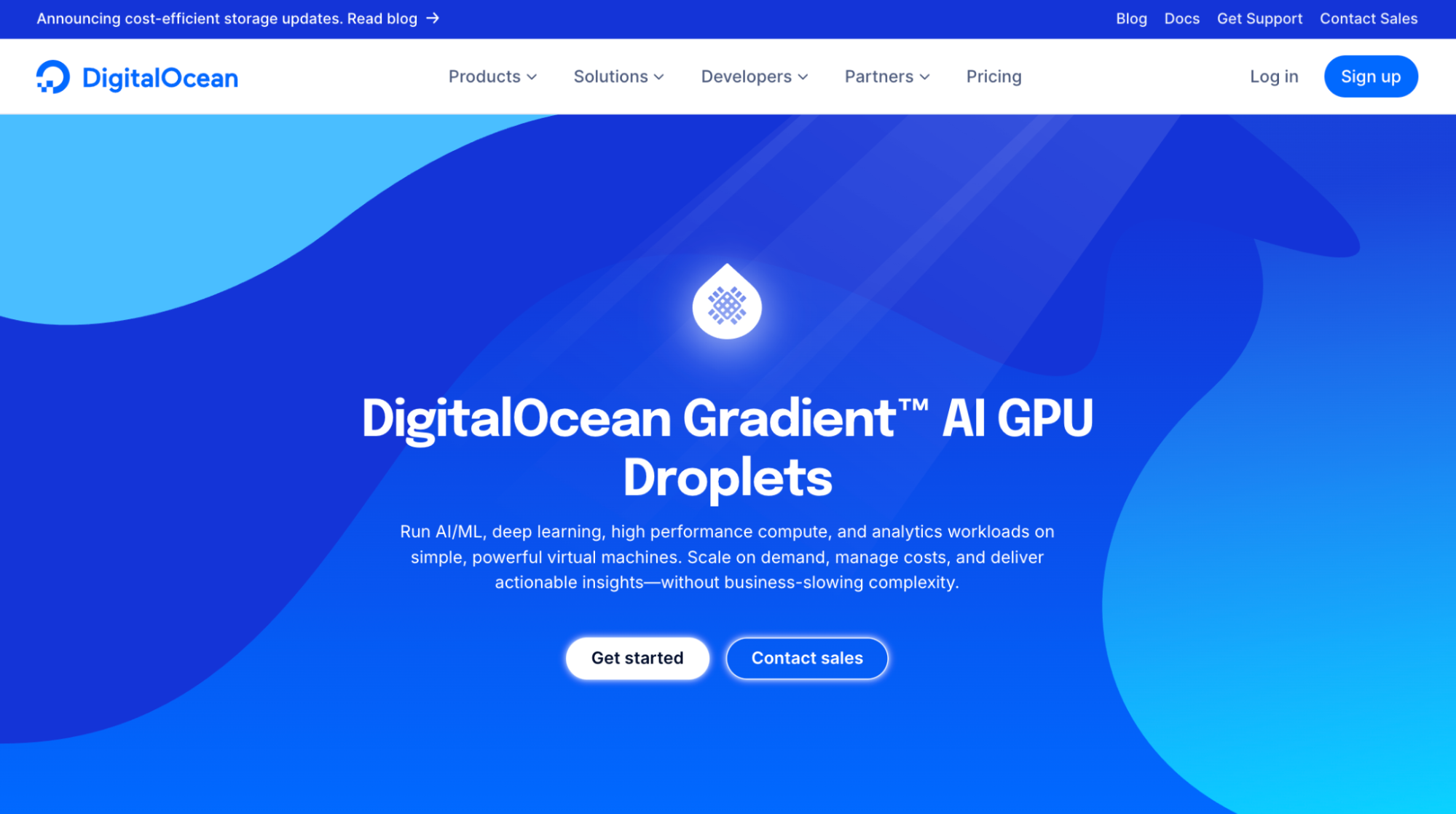
DigitalOcean offers high-performance Gradient™ AI GPU Droplets and single-tenant access via Gradient™ AI Bare Metal GPUs, focusing on simplicity, affordability, and accessibility for developers as part of its comprehensive agentic cloud platform. Unlike traditional GPU platforms that require extensive configuration, DigitalOcean facilitates an easy-to-use experience with fast deployment. Its GPU resources are designed specifically for AI and machine learning tasks, particularly in terms of use cases such as experimentation, single model inference, and image generation. DigitalOcean’s GPU Droplets integrate with its broader ecosystem, offering services such as GPU Worker Nodes for DigitalOcean Kubernetes, Storage, Managed Databases, and App Platform, facilitating a holistic cloud experience.
Compared to hyperscalers like AWS, GCP, and Azure, which often have more complex billing structures, DigitalOcean offers straightforward, transparent options, making it an attractive choice for digital native enterprises (DNEs), AI-native businesses, and developers.
DigitalOcean key features:
-
Unified agentic cloud architecture that combines general-purpose cloud and Gradient™ AI into a cohesive environment for building full-stack AI applications.
-
GPU Droplet simplicity—GPUs come packaged with CPU, NVMe, networking, and storage by default, eliminating multi-step configuration required on hyperscalers.
-
Lower total cost of ownership (TCO) with transparent, predictable pricing and no complex egress structures—up to 80% lower inference TCO compared to hyperscalers.
-
Developer-friendly onboarding, with 8,000+ tutorials, educational resources, and one-click tooling that reduce time from idea to deployment.
DigitalOcean GPU options and pricing:
- DigitalOcean offers NVIDIA HGX H100, H200, L40S, RTX 4000 Ada Generation, RTX 6000 Ada Generation, AMD Instinct™ MI325X, and MI300X GPU instances in 1X GPU and 8X GPU configurations. These options provide flexibility for businesses or developers working on smaller-scale GPU projects up to projects requiring more intensive resources. Pricing ranges from $0.76-$3.44/hour, via a straightforward pricing model with generous bandwidth billing and transfer limits.
DigitalOcean Gradient™ AI GPU Droplets are simple, flexible, affordable, and scalable machines for your AI/ML workloads.
Reliably run training and inference on AI/ML models, process large data sets and complex neural networks for deep learning use cases, and serve additional use cases like high-performance computing (HPC).
2. Linode for developers who prefer VPS-style infrastructure
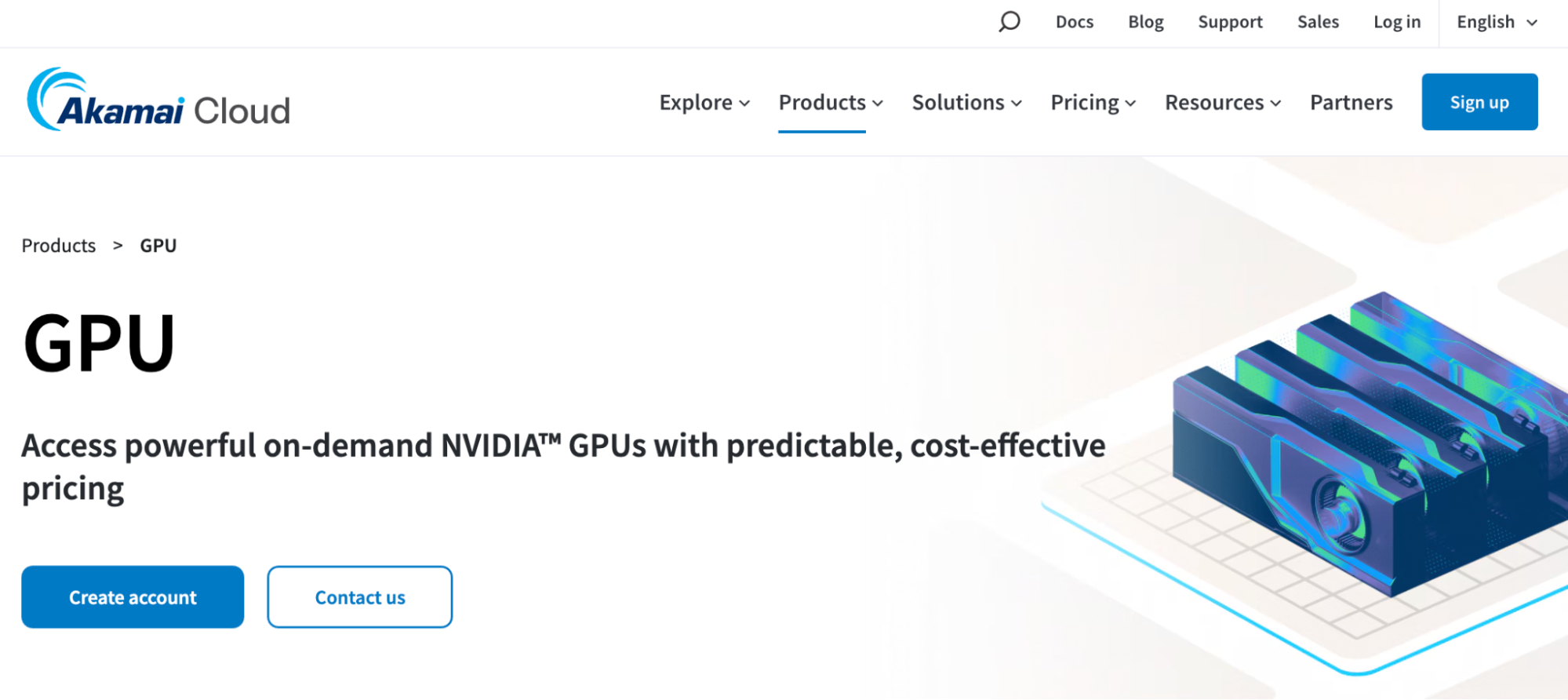
Linode offers a simplified GPU service for users who prioritize price-performance balance. Acquired by Akamai in 2022, Linode focuses on providing a straightforward cloud experience with GPU resources for machine learning, data analytics, and gaming. Unlike other providers with a broader GPU catalog, Linode offers just two GPU instances, the Quadro RTX 6000 and NVIDIA RTX 4000 Ada. Unlike many other cloud GPU providers shared on this list, Linode’s catalog is intentionally limited, with a focus on consistency over breadth. However, the availability of GPU instances is restricted to certain compute regions. With this in mind, Linode’s limited GPU selection is a drawback for enterprises that require more specialized or varied configurations.
Linode key features:
-
Simple, predictable VPS-style environment ideal for teams already familiar with traditional VM hosting.
-
Low-friction setup that works well for lightweight ML workloads, analytics, and GPU-accelerated gaming.
-
Straightforward pricing with fewer configuration choices reduces decision fatigue for smaller teams.
Linode GPU options and pricing:
- Linode offers the Quadro RTX 6000 and NVIDIA RTX 4000 Ada, with pricing ranging from $0.52 to $61.5 per hour.
Looking for Linode alternatives?
DigitalOcean offers robust cloud solutions for digital native enterprises, AI-native businesses, startups, and developers who need a simple, cost-effective solution tailored to their needs.
3. OVHcloud for budget GPUs and basic ML/analytics
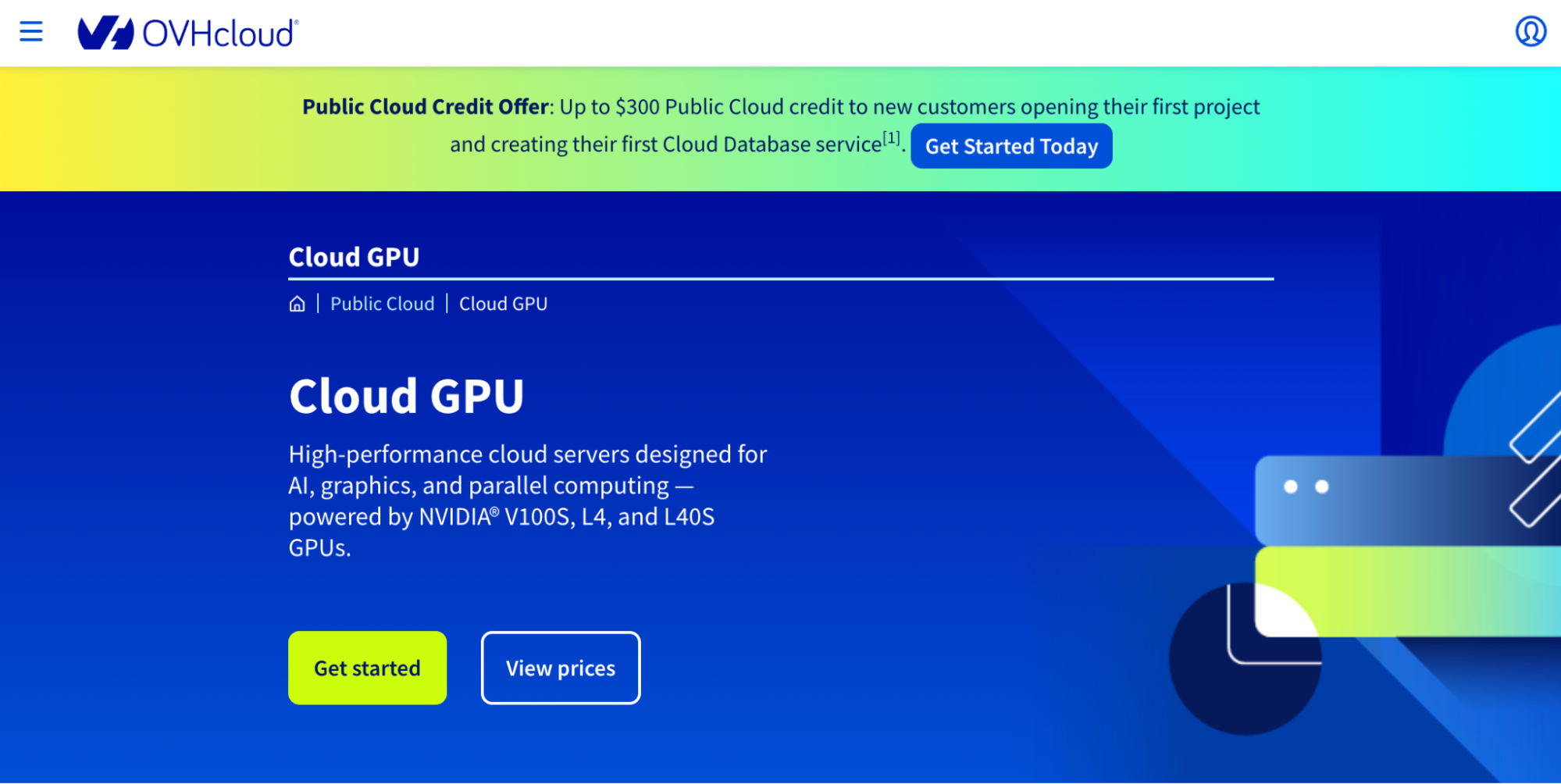
OVHcloud (OVH), which initially offered web hosting solutions, has recently expanded its offerings to include GPU-accelerated cloud services. The service provides a range of NVIDIA GPUs optimized for workloads, including generative AI inference, deep learning, 3D rendering, and computer vision. Its offering supports configurations with 1 or 4 GPUs per instance and can be upgraded to higher models after reboot, with GPU cards served via PCI Passthrough for direct hardware access. Instances can be managed via the OVHcloud Control Panel, API, or command line, and include high-performance NVMe storage and up to 25 Gbps networking.
OVHcloud key features:
-
Environmental sustainability initiatives, including energy-efficient data centers and a commitment to reducing overall carbon footprint.
-
Flat, transparent network pricing, often simpler than hyperscalers for Europe-based customers handling moderate data transfer volumes.
-
Hybrid cloud interoperability with OVHcloud’s existing bare-metal and hosted infrastructure for teams already invested in their ecosystem.
OVHcloud GPU options and pricing:
- OVHcloud offers NVIDIA H100, V100S, A10, L40S, L, and Quadro RTX 5000 GPUs. Pricing ranges from $0.88 to $1.80 per hour and is structured on a pay-as-you-go model, where the instance size and usage duration determine costs.
Explore a detailed comparison of DigitalOcean vs. OVHcloud to help you choose the right cloud solution for your business.
4. Vultr for globally-distributed workloads with lighter GPU needs
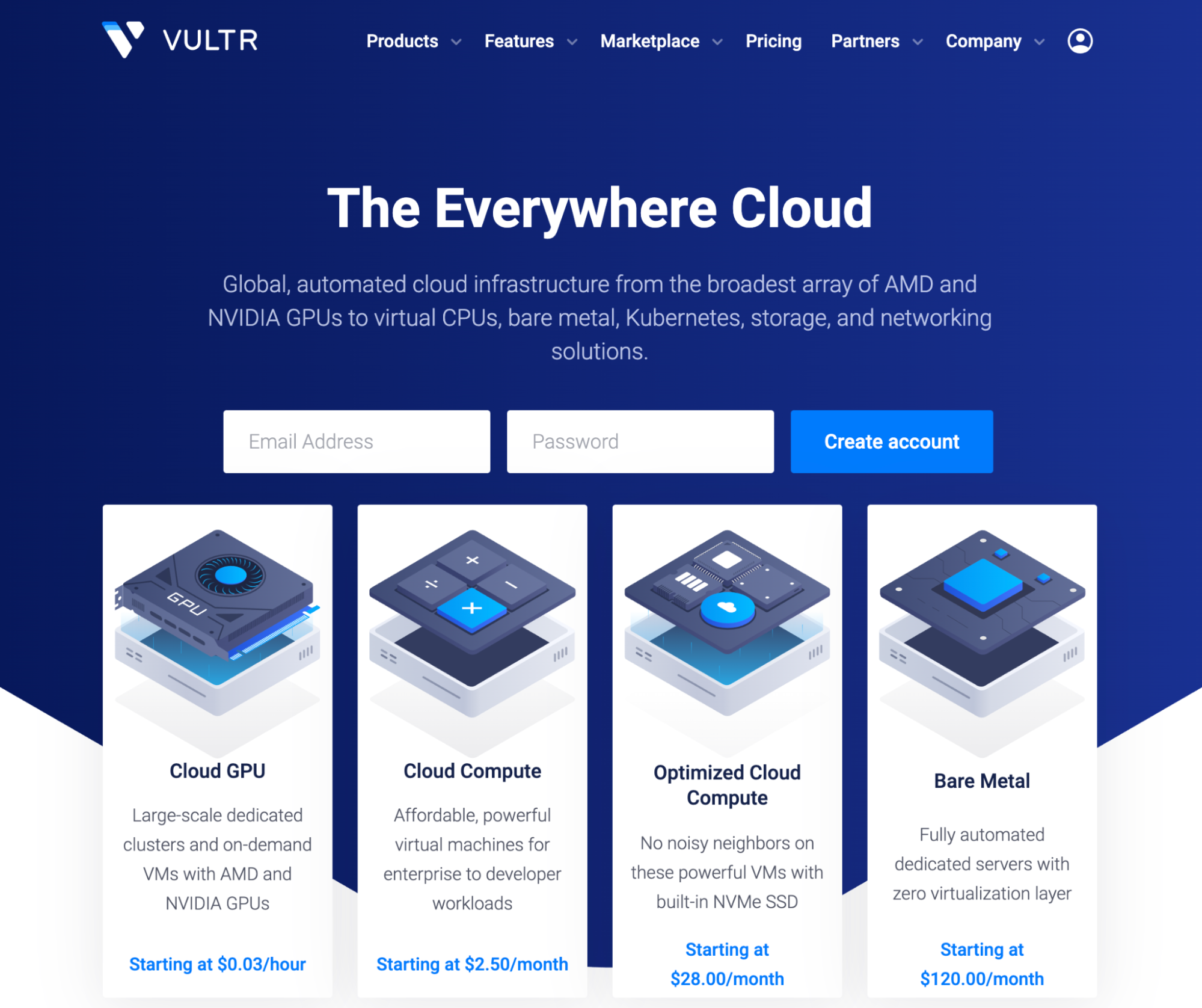
Vultr provides global access to AMD and NVIDIA GPUs for AI/ML, AR/VR, high-performance computing, and VDI/CAD workloads, available on demand as virtual machines or bare metal.
Users can deploy GPU-accelerated Kubernetes clusters through Vultr Kubernetes Engine or scale GenAI models with Vultr Serverless Inference for rapid deployment. Instances can be managed through API or Terraform, with features including automatic backups, server snapshots, flexible networking, and DDoS protection. The platform includes access to Vultr Marketplace for plug-and-play applications and Container Registry for containerized services, with options for both reserved capacity and on-demand instances. Vultr may not be the best fit for large regulated enterprises or extremely large-scale distributed training workloads due to its smaller team size and limited customer support options.
Vultr key features:
-
Global footprint with 32+ data center regions, giving users strong geographic coverage for latency-sensitive or edge-adjacent deployment needs.
-
Predictable, pay-as-you-go pricing across regions, with fewer pricing variables than hyperscalers.
-
Appealing for gaming, VFX, and rendering workloads, where regional availability matters more than top-tier GPU performance.
Vultr GPU options and pricing:
- Vultr offers several cloud GPU options, including MI300X, B200, H100, L40SGH200, A100, A40, and A16. Pricing ranges from $0.118 to $19.178 per hour, based on the GPU and its configuration.
Read our thorough comparison of Vultr alternatives to understand available cloud service provider options.
5. Vast AI for researchers and tinkerers that don’t require managed cloud experiences
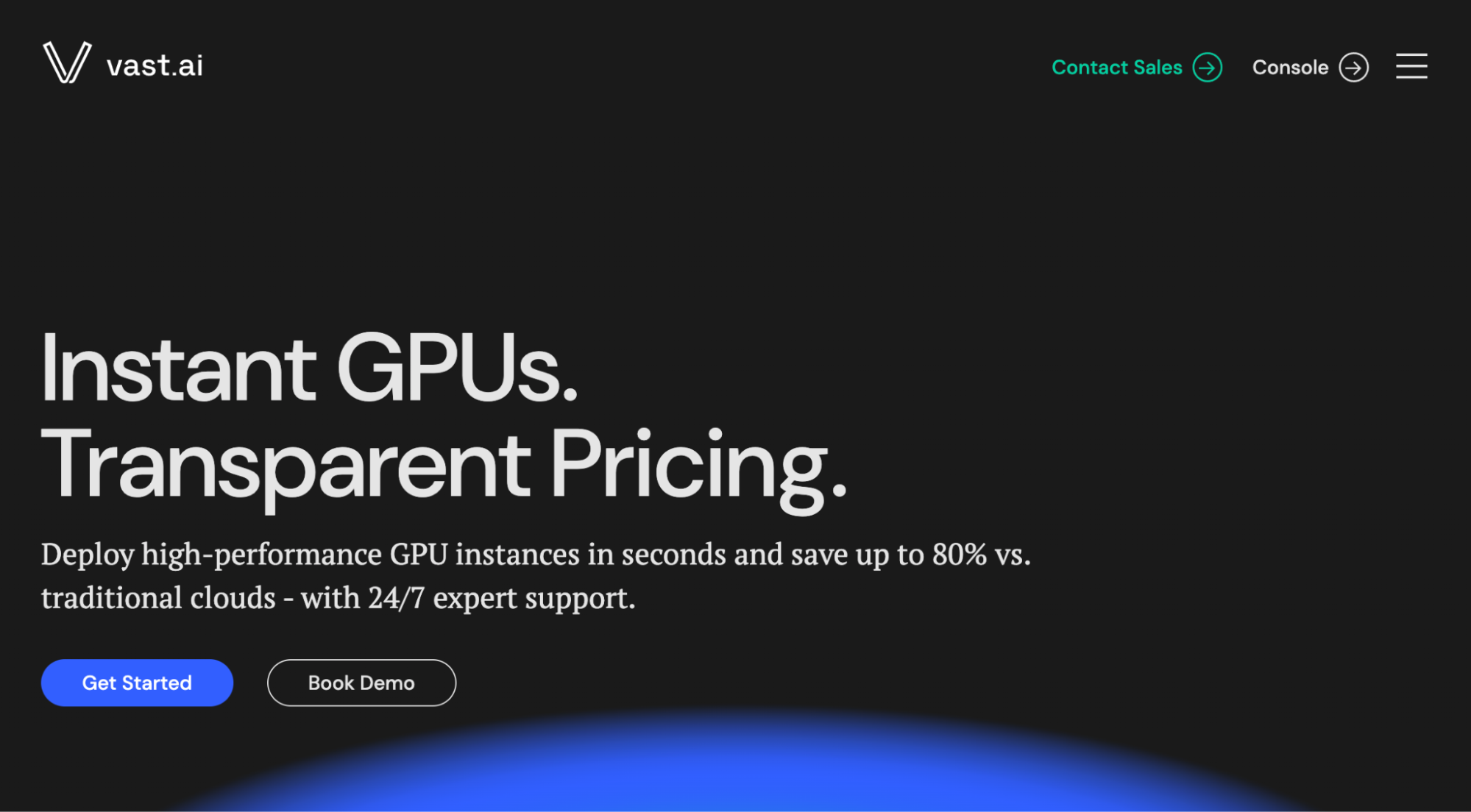
Vast AI is a global marketplace for renting affordable GPUs, enabling businesses and individuals to perform high-performance computing tasks at lower costs. The platform’s unique model allows hosts to rent out their GPU hardware, giving clients access to various computing resources for fluctuating workloads. Additionally, Vast AI offers simple interfaces for launching SSH sessions or using Jupyter instances, focusing on deep learning tasks.
One of Vast AI’s key features is its DLPerf (Deep Learning Performance) function, which estimates deep learning tasks’ performance based on the chosen hardware configuration. Note that, unlike many traditional cloud platforms, Vast AI does not offer remote desktop support, and its systems operate exclusively on Ubuntu.
Vast AI key features:
-
Marketplace-based GPU pricing, often offering the lowest rates available for users who prioritize cost above ecosystem or support.
-
Global coverage with 40 secure datacenters with ISO 27001 certification.
-
24/7 expert customer support and SLAs available.
Vast AI GPU options and pricing:
- Vast AI offers cloud GPU instances that include RTX 5090, 4090, 3090, H200, and H100. Pricing ranges from $0.043 to $4.709/hour.
Hyperscalers
Modern GPU cloud providers, including hyperscalers like AWS, Google Cloud, and Azure, offer scalable, high-performance GPU solutions for applications involving machine learning, AI, and data analytics.
6. Amazon Web Services (AWS) for intensive AI/ML workloads
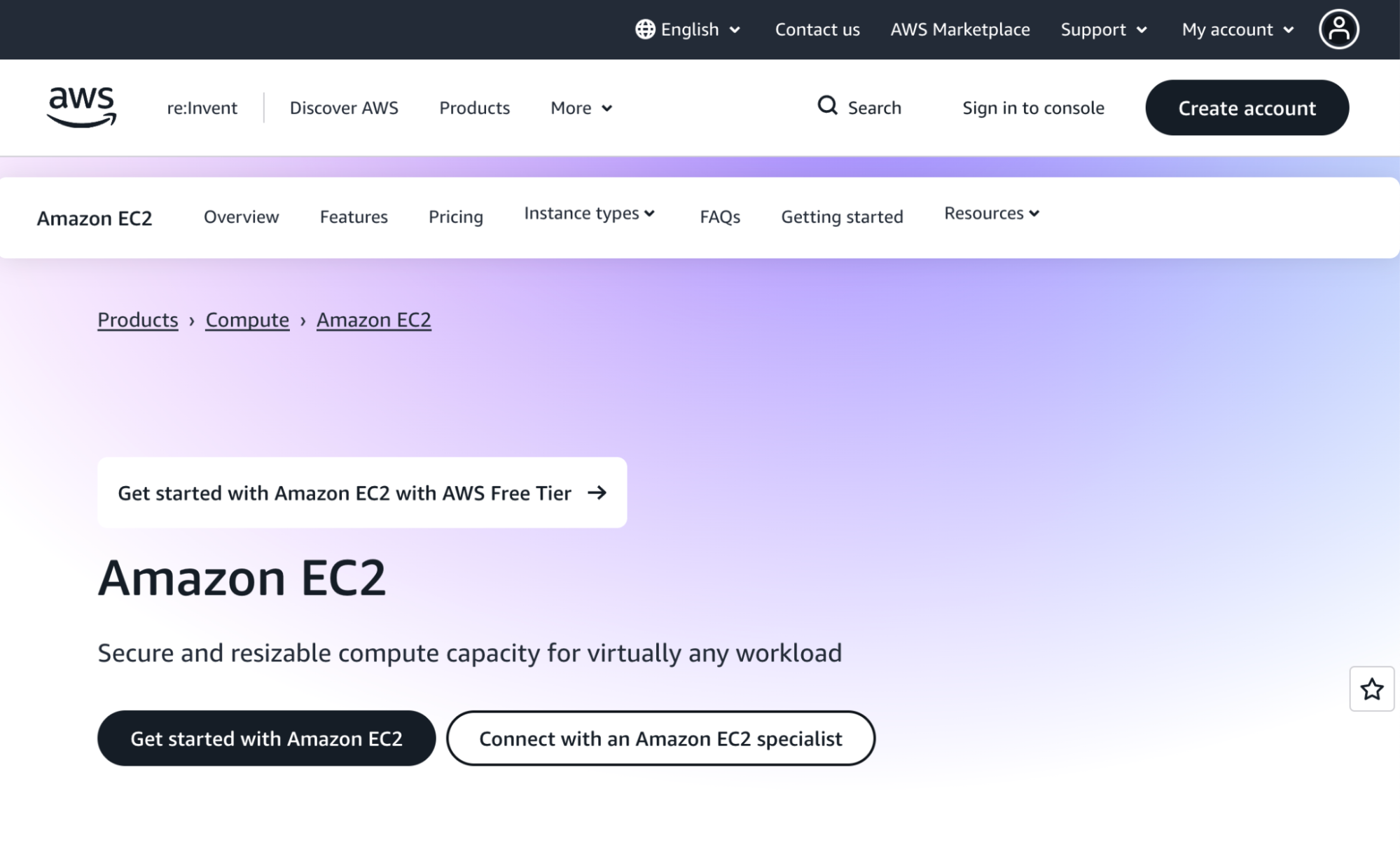
Amazon Web Services provides a variety of GPU instances for businesses requiring computing power for intensive workloads like machine learning, scientific simulations, and data analytics. Core services such as Amazon EC2 enable users to harness GPU capabilities to speed up model training and data processing tasks. EC2 provides flexibility by allowing users to configure instances based on their specific needs. AWS’s global network ensures low-latency resource access, facilitating efficient deployment across multiple regions.
While AWS is certainly comprehensive, its complexity is often cited as a barrier for new users. GPU configuration on EC2 can be time-consuming, and setup involves a learning curve due to the platform’s breadth. As a result, AWS is more suitable for enterprises handling large-scale GPU workloads, particularly those committed to longer-term projects through reserved instances.
Amazon Web Services key features:
-
Reserved instance and Savings Plan options that benefit organizations making multi-year, large-scale infrastructure commitments.
-
Granular IAM, governance, and compliance frameworks, tailored for highly regulated or security-focused enterprises.
-
Wide catalog of specialized GPU instance families (P-series, G-series, Trn, Inferentia, etc.) designed for specific enterprise-class AI, simulation, and HPC workloads.
Amazon Web Services GPU options and pricing:
- AWS offers a range of GPU instances, including the B200, H200, A100, V100, M60, T4, and L4. Pricing varies by GPU type and usage model. For instance, the G4 instances start at $0.379 per hour.
Learn more about why AWS is complicated and strategies for AWS cost optimization.
7. Google Cloud Platform for teams requiring deep Google data product integration
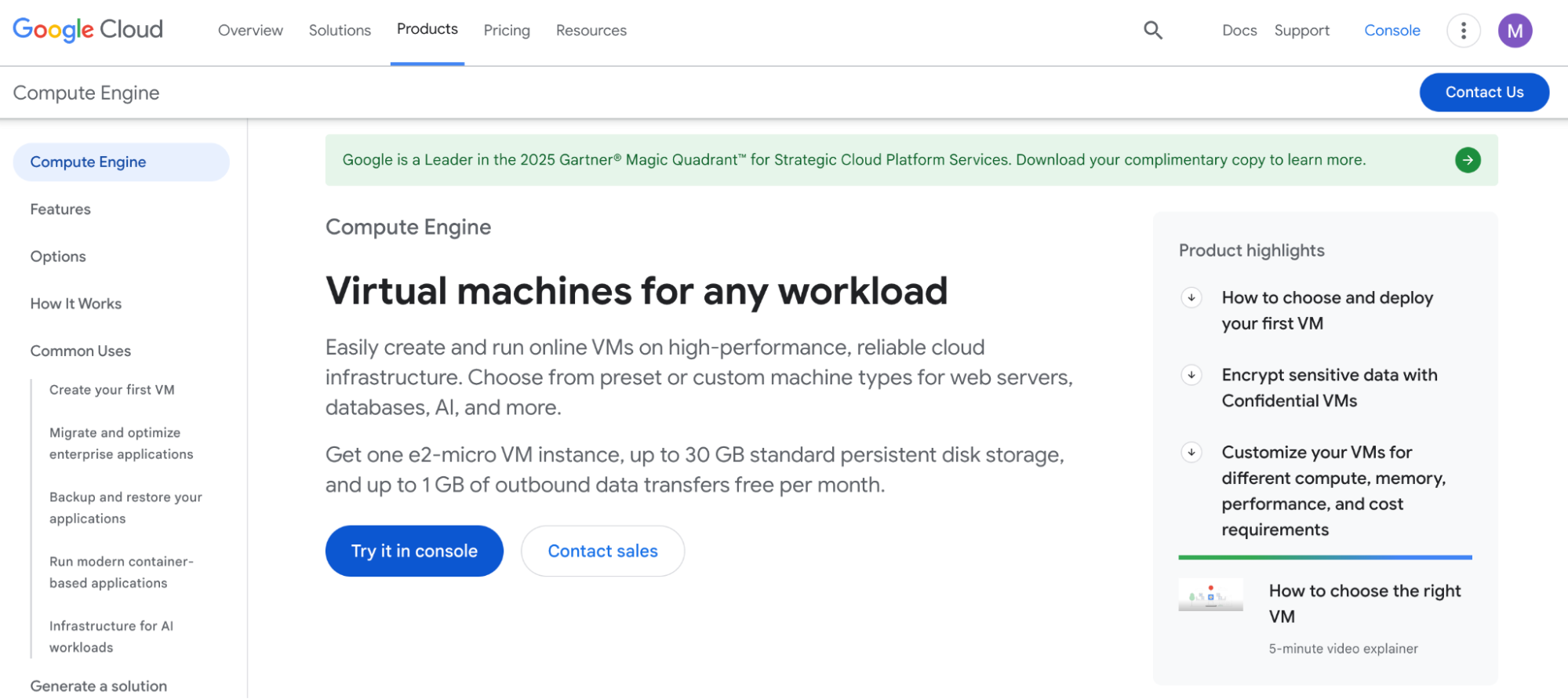
Google Cloud Platform (GCP) is another primary provider of GPU computing solutions, well-suited for workloads that demand high-performance resources, such as machine learning, 3D rendering, and AI model inference. The integration of GPU acceleration within GCP’s Dataflow offering allows real-time data processing, adding value to workflows that require immediate computation. Like AWS, GCP operates through a global network, ensuring users can effectively scale deployments across multiple regions.
GCP’s approach differs from some other GPU providers mentioned here because their GPU instances are available as an “add-on” to virtual machines (VMs). While this offers flexibility in pairing GPU resources with any VM, it also complicates the pricing structure, as VM and GPU costs must be combined for accurate and complete calculations. This structure may appeal to users looking for fine-tuned configuration options.
Google Cloud Platform key features:
-
Highly customizable VM + GPU architecture, giving advanced users granular control over hardware pairings not typically required by smaller dev teams.
-
Global private fiber network that benefits distributed enterprise workloads and real-time data processing.
-
Comprehensive governance, IAM, and enterprise security tooling, suited for large companies with complex compliance requirements.
Google Cloud Platform GPU options and pricing:
- GCP provides several GPU instance types, including the T4, P4, P100, and V100. Prices range from $0.35 to $2.48 per hour, suitable for businesses needing customizable and scalable GPU solutions.
8. Microsoft Azure for enterprises embedded in the Microsoft ecosystem
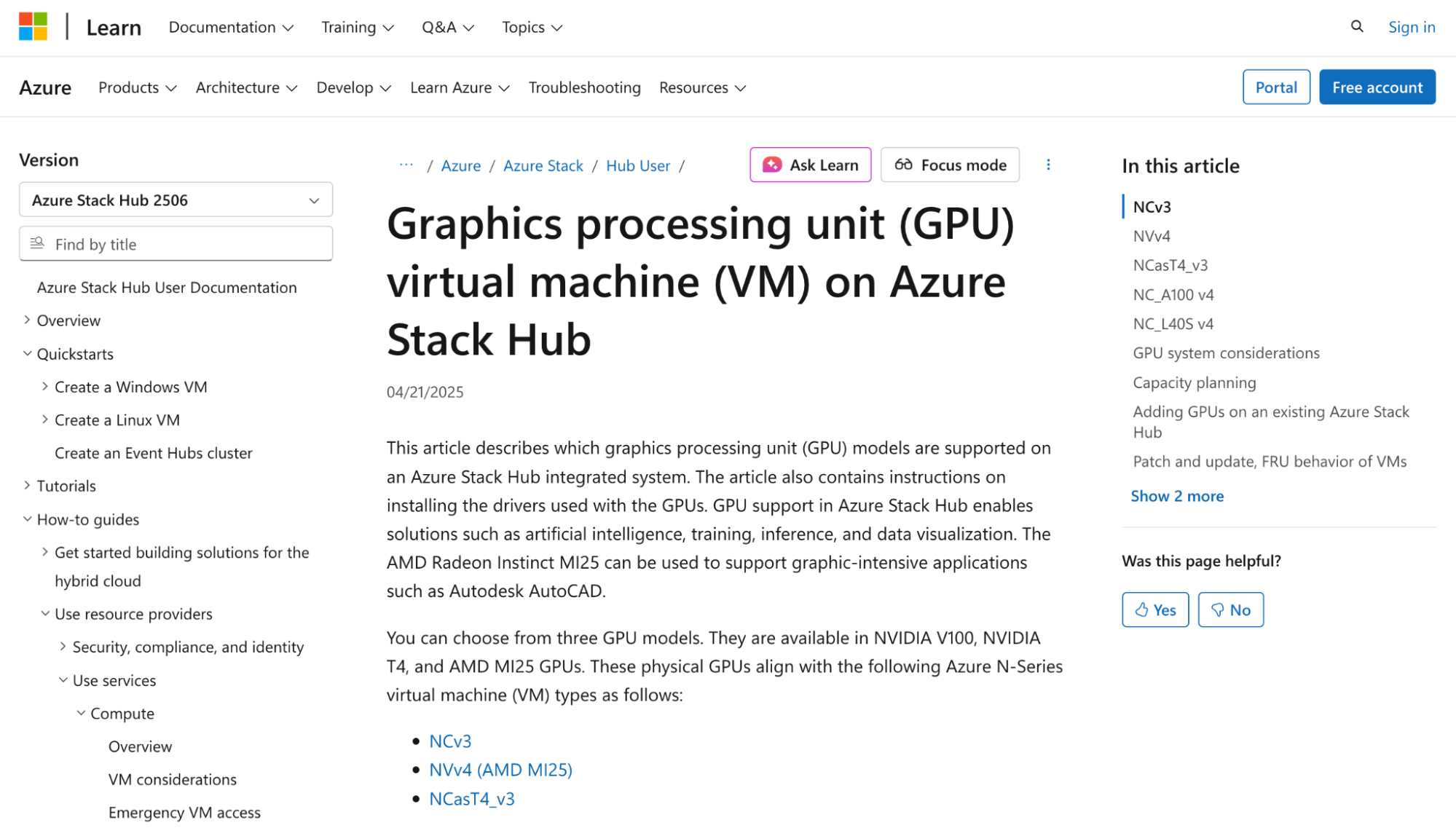
Microsoft Azure offers GPU instances for tasks requiring substantial computational power, including machine learning, AI, and scientific computing. NVIDIA GPUs, such as the Tesla V100, T4, and A100, provide users with the flexibility to handle diverse workloads. Azure’s integration with the broader Microsoft ecosystem makes it appealing for businesses using other Microsoft services, such as Office 365 or Power BI, simplifying data workflows and ensuring consistency across platforms. GPUs can be added to existing Azure Stack Hub systems and are managed through the standard Azure portal interface with support for capacity planning and compatibility with patch/update operations.
Like AWS and GCP, Azure’s setup can be time-intensive, especially for larger projects with complex requirements. While its interface provides detailed information on each GPU instance, users may find navigating the variety of offerings challenging. Nonetheless, Azure stands out for its scalability, enabling businesses to quickly expand GPU resources to meet changing demands.
Microsoft Azure key features:
-
Provides PowerShell-based driver deployment using Set-AzVMExtension cmdlet, supporting both NVIDIA (CUDA and GRID) and AMD drivers with options for connected and disconnected environments.
-
Extensive compliance and governance certifications, appealing to sectors that require strict regulatory alignment (finance, government, healthcare).
-
Granular identity and access management (IAM) via Azure Active Directory, enabling centralized control across large organizations.
Microsoft Azure GPU options and pricing:
- Azure provides GPU instances, including the K80, T4, P40, P100, V100, and A100, with pricing ranging from $0.90 to $4.352 per hour. Pricing models include pay-as-you-go, reserved, and spot instances and vary widely based on service type, usage, and selected pricing model.
Learn more about Microsoft Azure’s hidden costs and strategies to identify and avoid them, and understand why Azure is so expensive, to better optimize your cloud computing costs.
9. IBM Cloud for regulated industries requiring hybrid cloud
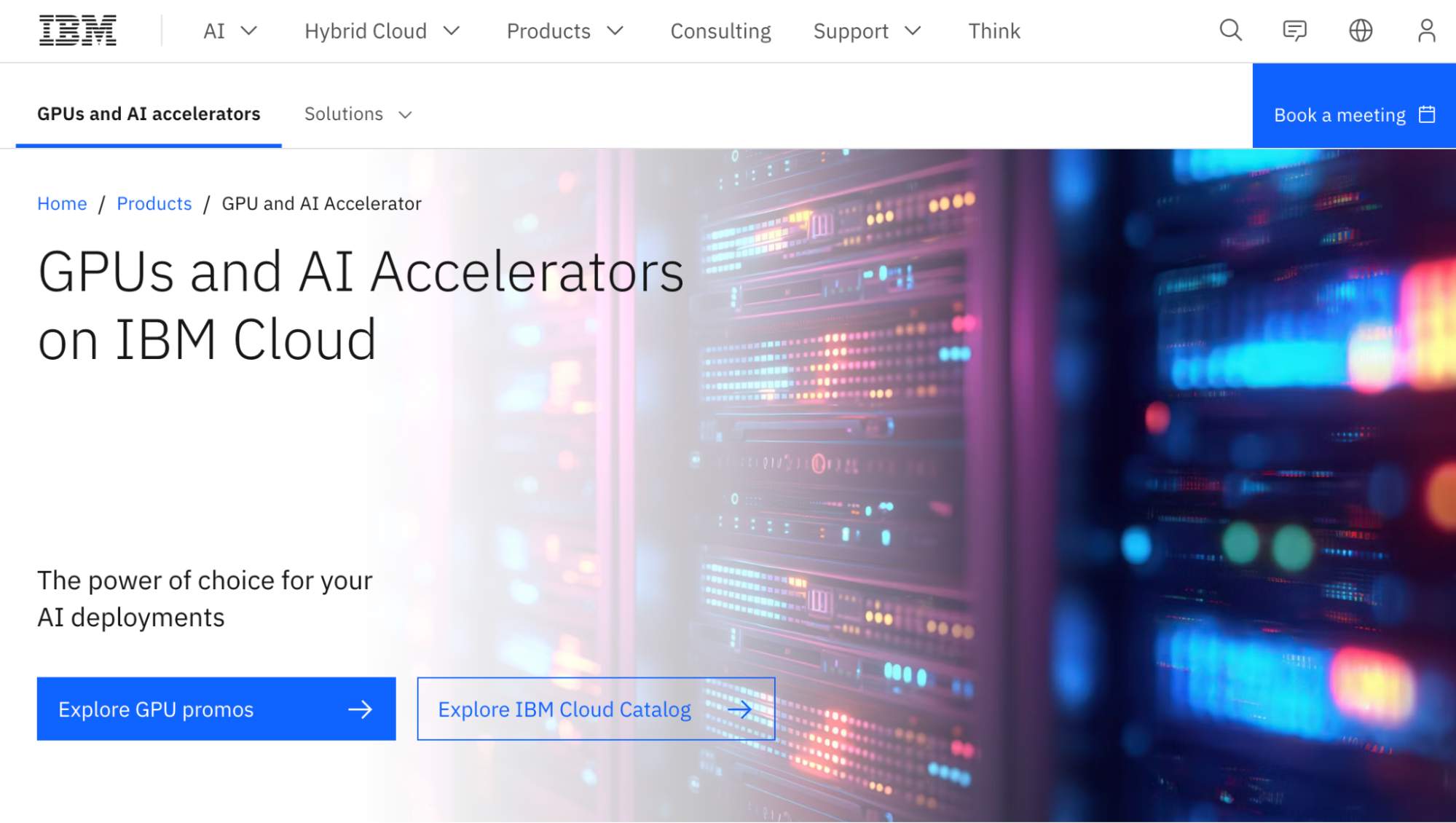
IBM Cloud provides GPU-accelerated services to support AI, machine learning, and high-performance computing. IBM’s platform emphasizes flexibility, allowing users to scale GPU resources on demand for businesses that need to adjust their infrastructure based on fluctuating workloads. IBM Cloud is suited for hybrid cloud deployments and businesses that use IBM’s suite of software and services.
Unlike other providers like AWS, Azure, and GCP, IBM Cloud focuses on customized solutions for industries with specific regulatory needs, such as finance and healthcare. Its strong support for AI and data analytics workloads, combined with scalable infrastructure, makes IBM a viable choice for businesses that require computational power and rigorous data management and governance.
IBM Cloud key features:
-
Deep alignment with regulated industries, offering compliance frameworks for finance, healthcare, government, and other high-governance sectors.
-
Hybrid cloud tooling through Red Hat OpenShift and IBM’s hybrid management suite, supporting long-term mixed on-prem/cloud deployments.
-
Customizable infrastructure and consulting-heavy support, appealing to enterprises needing tailored architectures rather than self-serve cloud.
IBM Cloud GPU options and pricing:
- IBM Cloud offers GPU instances, including the L4, L40S, V100, H200, A100, MI300X, and Intel Gaudi 3. Pricing is based on a pay-as-you-go model or through the Cloud Pak for Applications framework, offering flexibility for businesses with different operational requirements.
10. Oracle Cloud Infrastructure for organizations prioritizing database-driven AI workloads
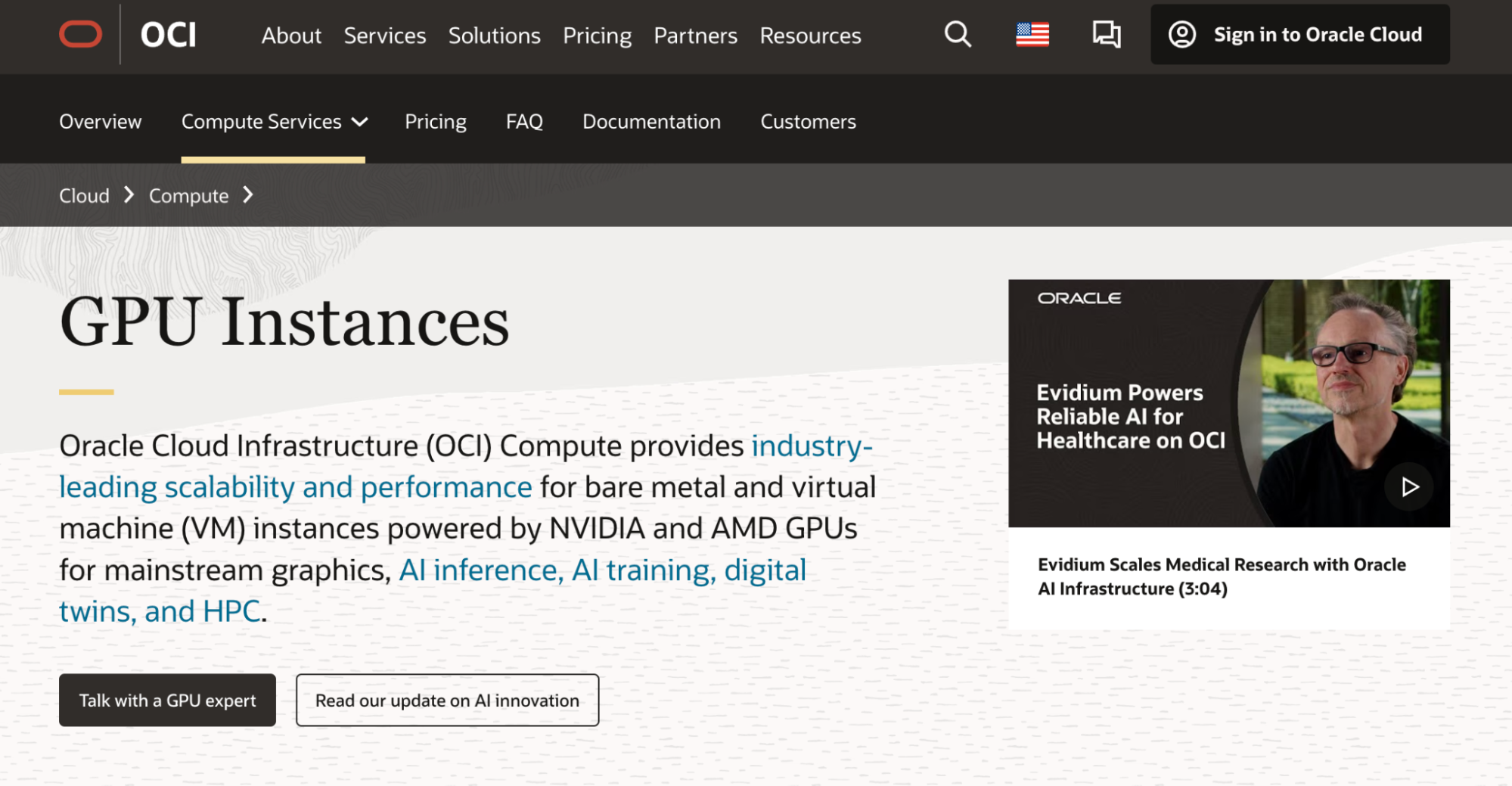
Oracle Cloud Infrastructure (OCI) delivers powerful GPU computing resources, including NVIDIA GPUs for high-performance workloads and complex data processing tasks such as AI, machine learning, and advanced analytics. OCI also offers security features, including encryption and detailed Role-Based Access Controls, helping ensure that sensitive data is well-protected.
OCI stands out for its cost flexibility, providing on-demand and reserved instance pricing models. This allows businesses to manage their GPU resources more effectively, depending on project duration and scale. OCI’s global infrastructure makes it a suitable choice for enterprises looking to take advantage of GPU acceleration for important workloads, especially in industries where data integrity and security are a priority.
Oracle Cloud Infrastructure key features:
-
Multi-year cost optimization options (Reserved Instances + Commitments) ideal for enterprises with predictable, long-term GPU usage.
-
Advanced security posture including hardware-level encryption, strict RBAC, and compliance frameworks for regulated sectors.
-
Deep specialization in mission-critical workloads, serving industries that require strong guarantees around data sovereignty, integrity, and auditability.
Oracle Cloud Infrastructure GPU options and pricing:
- OCI offers a selection of NVIDIA GPU instances, including the H100, A100, A10, V100, and P100. Pricing ranges between $1.275 to $16 per hour and is calculated based on workload requirements and budgeting needs.
11. Genesis Cloud for EU organizations with large multi-GPU cluster needs
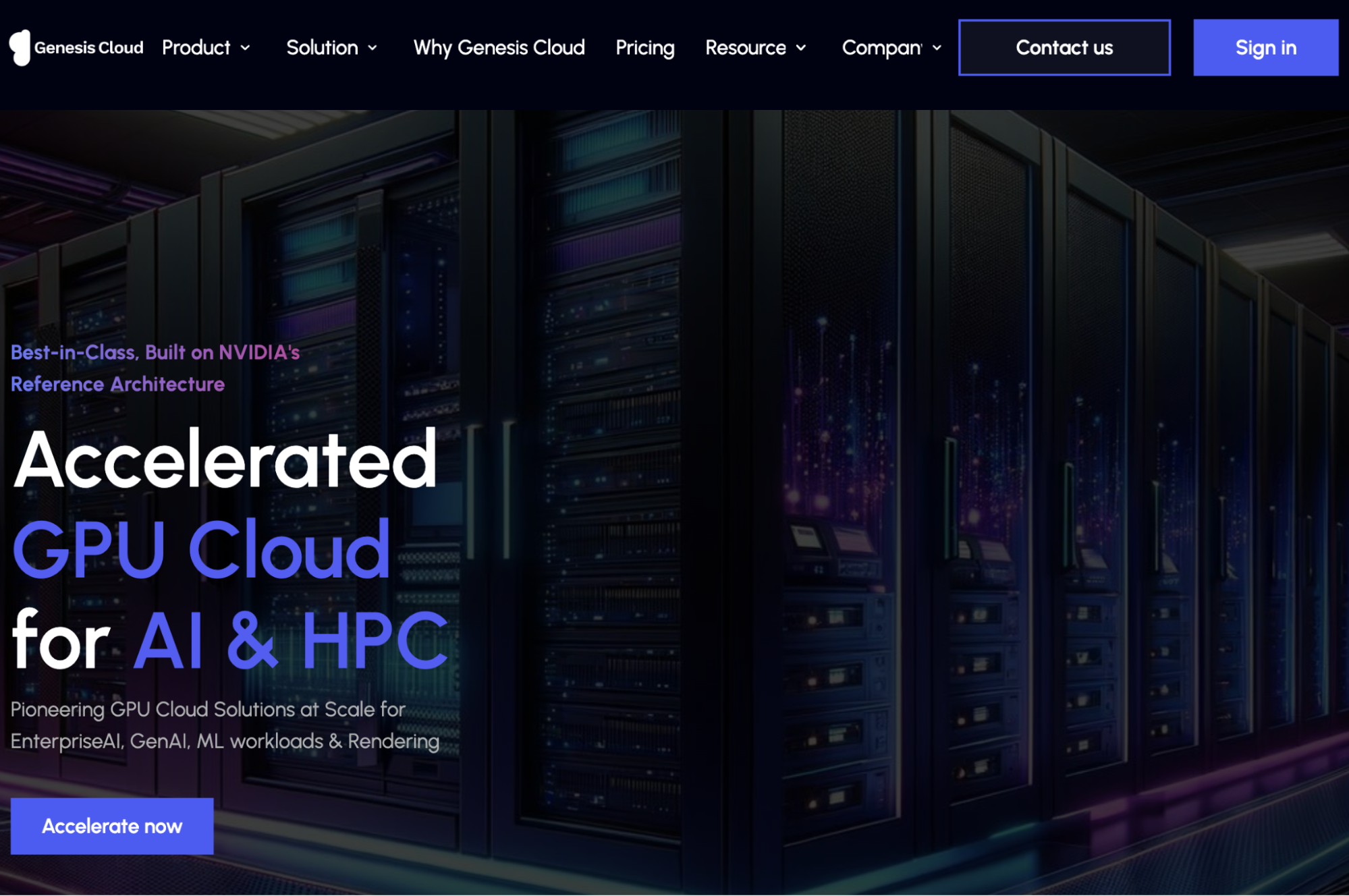
Genesis Cloud is a European GPU-first cloud provider tailored for AI training, inference, and HPC workloads. Its compute dashboard interface is simple, and its prices are comparatively cheaper than most platforms for similar resources. It’s known for its support of the PyTorch and TensorFlow frameworks.
Genesis Cloud is suitable when you’re looking to scale up, but not as cost-efficient if your GPU needs are minimal and limited to small jobs. Note that the minimum configuration for H100 and H200 offerings is one full node, rather than a single GPU. Its offerings are hardware-rich but not the best pick if you need a full MLOps stack.
Genesis Cloud key features:
-
Enterprise-scale European Union “sovereign” cloud focus for compliance and privacy.
-
Sustainability focus, using 100% renewable energy in their data centers.
-
Modern GPU hardware (including large multi-node configurations) with offerings designed explicitly for Gen AI, LLM, and large multi-node training workloads.
Genesis Cloud GPU options and pricing:
- Genesis Cloud’s GPU instances include NVIDIA H100, H200, B200, 4090, 3090, and 3080. Pricing ranges from $0.08 to $2.80 per hour.
Neocloud providers
Neocloud providers are GPU-focused clouds optimized for high-intensity AI training, offering the latest NVIDIA chips and fast interconnects that support distributed training at scale. Unlike general-purpose clouds, they exist primarily to maximize performance for compute-heavy workloads, often with premium pricing to match.
12. CoreWeave for teams training frontier-scale models
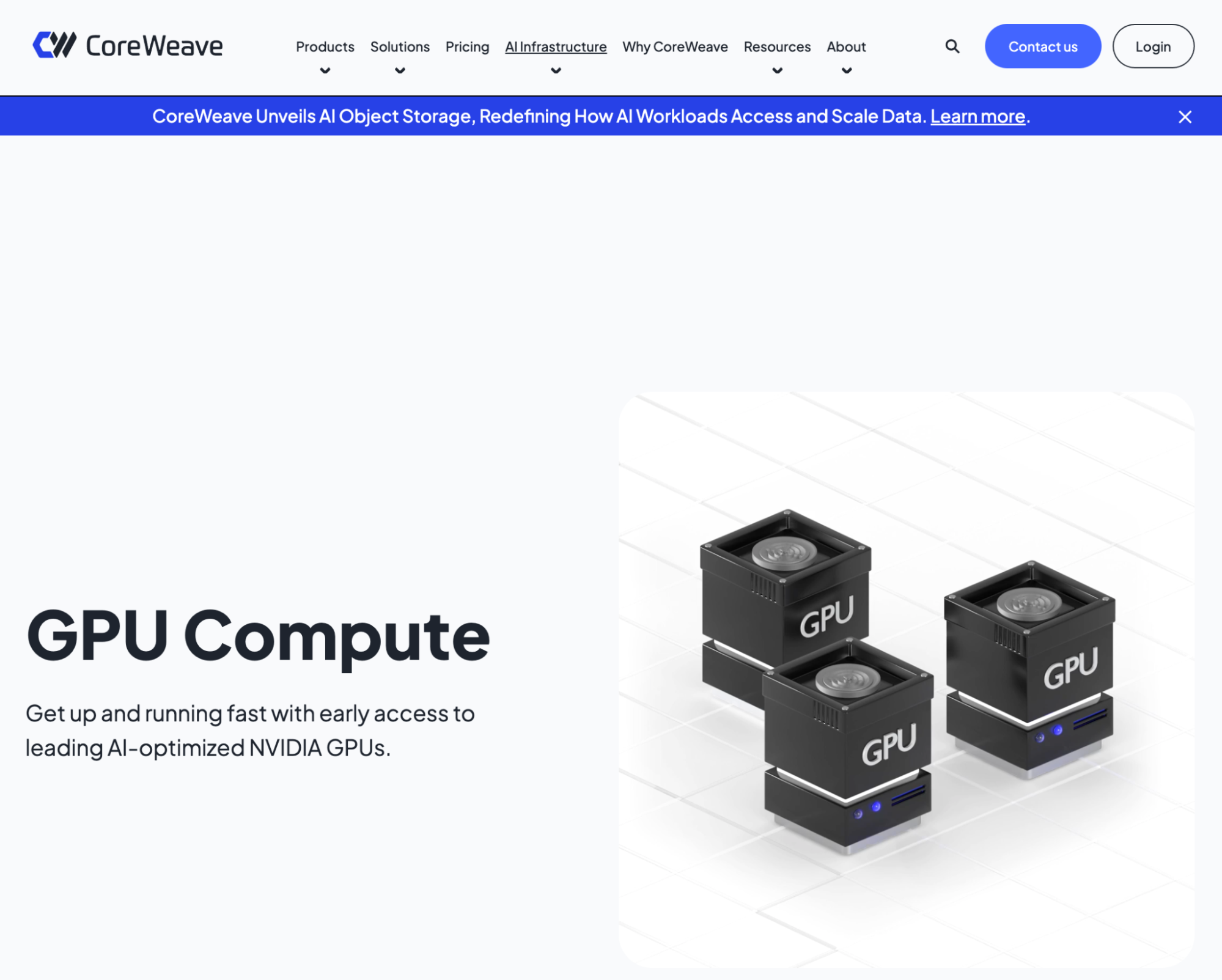
CoreWeave provides configurable GPU instances for users with specific, resource-heavy workloads, such as machine learning, rendering, VFX, and simulations. As a neocloud provider, CoreWeave focuses on delivering high-performance computing at scale, offering access to NVIDIA GPUs, high-bandwidth networking, and specialized infrastructure for distributed training.
CoreWeave’s platform is built around speed and scale, with fast provisioning and performance-optimized clusters tailored to AI workloads. However, users should be aware of potential downsides, including additional networking or storage fees that can make total cost less predictable. CoreWeave also lacks some of the simplified onboarding resources (like starter templates or pre-built images) seen in more general-purpose clouds, and its pricing is typically higher than traditional providers.
CoreWeave key features:
-
Fast provisioning and autoscaling designed for teams running demanding, bursty workloads.
-
Specialized clusters tailored for ML training, rendering, and VFX pipelines.
-
Optimized performance for large-scale compute, including support for high-throughput workloads and advanced interconnects.
CoreWeave GPU options and pricing:
- CoreWeave supports GPUs like the NVIDIA A100, H100, H200, L40S, plus the AMD Genoa and Turin. Pricing ranges from $5.31 to $68.80 per hour, based on the resources requested or consumed within each minute.
13. Lambda Labs for ML researchers requiring high-end training GPUs

Lambda Labs has centered AI as its focus since its initial founding, building deep learning servers and workstations before moving into the cloud GPU space more recently. It’s particularly known for both its developer-friendly platform and competitive pricing. Its Lambda Stack offers a curated set of software packages—including TensorFlow, PyTorch, and Ubuntu—confirmed compatible across their systems and GPUs.
One consideration with Lambda Labs is that capacity can be limited for certain GPU types, especially during periods of high demand. Some GPUs or clusters may only be available in specific regions. Additionally, Lambda’s platform is simpler than the major hyperscalers, which means enterprise-grade features (e.g., broader global presence, compliance frameworks, or multi-region redundancy) may feel more limited for larger organizations.
Lambda Labs key features:
-
Access to NVIDIA GPUs optimized for deep learning workloads.
-
Simple, transparent pricing that appeals to researchers and startups running cost-sensitive training jobs.
-
Strong performance for single-node and small-cluster training, though availability may vary by GPU type or region.
Lambda Labs GPU options and pricing:
- Lambda Labs offers just a few GPU options across their pricing models: the NVIDIA H100 in its 1-click clusters and NVIDIA B200, H100, A100, and V100 for on-demand instances. Pricing ranges from $0.50 to $4.99 per hour based on the configuration and pricing model.
Compare your cloud GPU provider options in our list of Lambda Labs alternatives.
14. Runpod for builders deploying serverless inference at scale
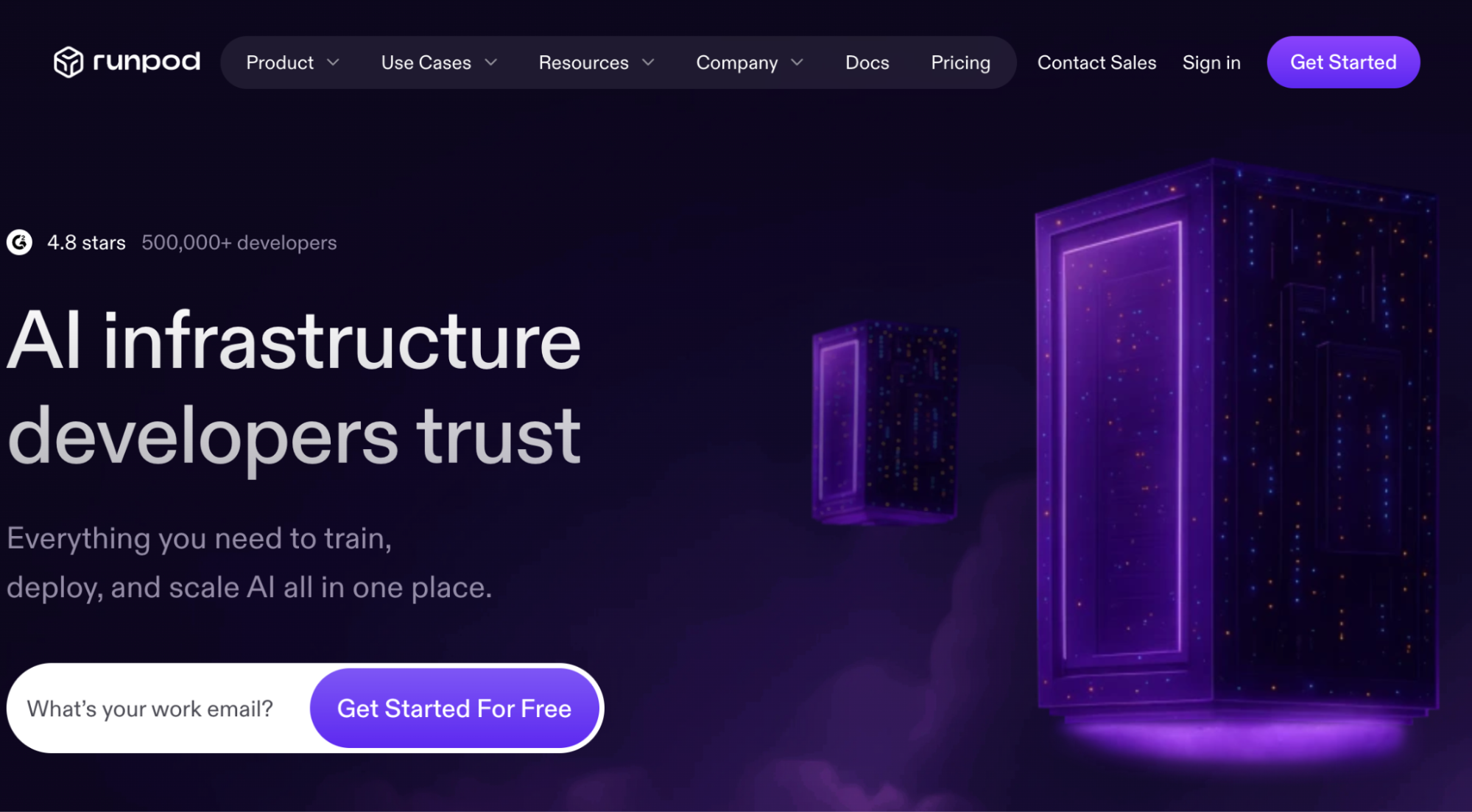
Runpod is a runtime platform with cloud GPUs offered across 31 global regions and a wide selection of modern GPUs. Though not a full end-to-end cloud solution, it offers a range of benefits for large-scale AI, ML, and HPC workloads. Specifically, it’s serverless offering abstracts infrastructure management, and the beta Runpod Hub offers one-click deployment for open-source AI projects.
Some users have also reported slow cold starts with larger models. Finally, its Community Cloud/Secure Cloud split creates a user trade-off, forcing a choice between affordability and enterprise reliability.
Runpod key features:
-
Cost-efficient runtime billing, charging only for active GPU use and offering automatic shutdown/cold-start behavior for further savings.
-
Persistent S3-compatible network storage with unlimited data processing and zero ingress/egress fees.
-
Real-time logs, monitoring, and metrics without custom frameworks.
Runpod GPU options and pricing:
- Runpod offers several cloud GPUs, including B200, H200, H100, A100, L40, and A6000, with pricing that ranges from $0.27 to $0.64 per hour (with options for billing by the second). Runpod operates a number of pricing models, with separate options for Community cloud, Secure Cloud, and Serverless—note that storage adds increased cost.
Check out the top Runpod alternatives to determine the top AI infrastructure option for your AI-native business.
15. Tencent Cloud for Asia-based workloads
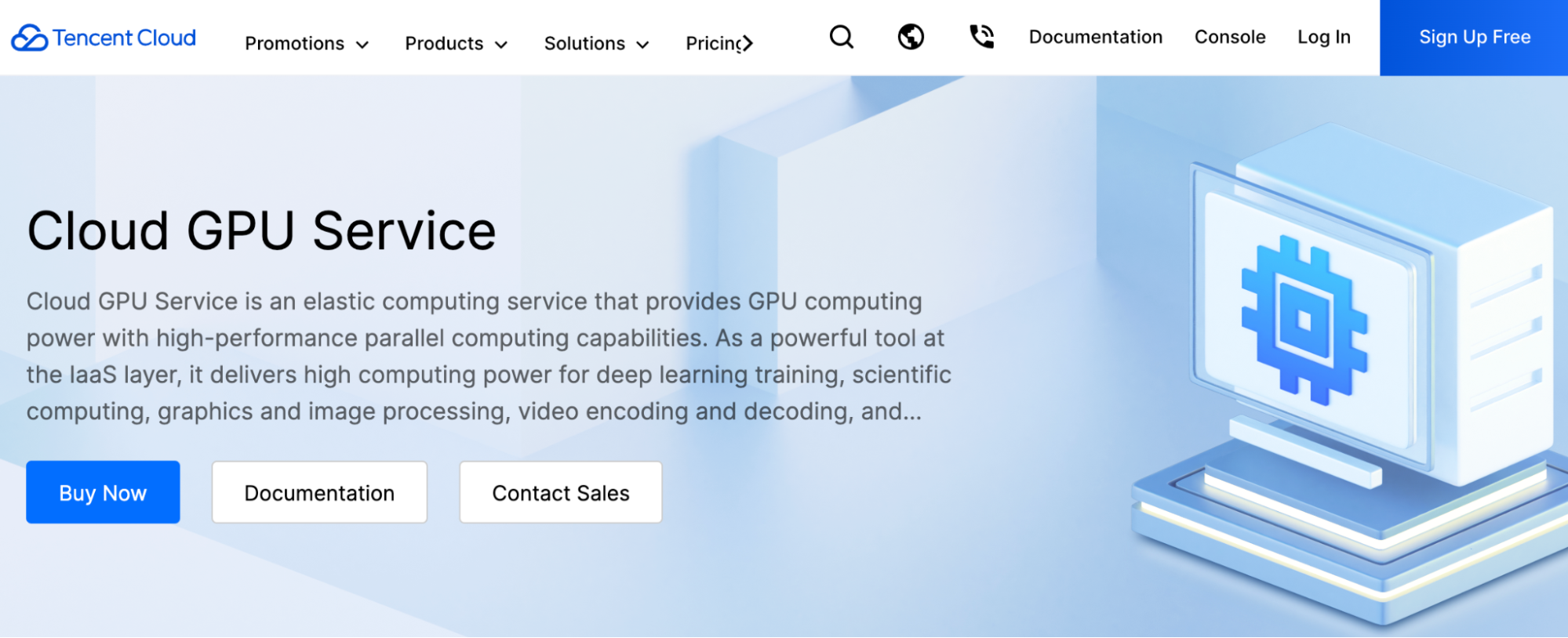
Tencent Cloud’s GPU service offers a flexible, pay-as-you-go pricing model. Choose between a wide variety of GPU-instance types and sizes, including multiple instance families and different GPU options, as well as various vCPU/memory configurations. Unlike some providers, with Tencent Cloud, you avoid paying for GPU compute when the instance is idle (assuming it’s shut down correctly per their terms). As a large provider, it supports multiple regions with a particularly strong presence in Asia.
Compared to other top cloud GPU providers, Tencent Cloud’s GPU options are not necessarily the latest-generation offerings and may not be suitable for large-scale training needs or integrated MLOps. Note that separate costs also apply for storage and network I/O.
Tencent Cloud key features:
-
Fast, stable, and elastic cloud GPU computing via various rendering instances.
-
Suitable for deep learning inference and training, video encoding and decoding, and scientific computing.
-
Auto-installed GPU drivers, CUDA, and cuDNN facilitate quick deployment environment setup.
Tencent Cloud GPU options and pricing:
- Tencent Cloud offers several NVIDIA cloud GPUs, including Tesla T4, P4, P40, and V100. Their pay-as-you-go pricing ranges from $0.49 to $2.68 per hour.
Note: Pricing and feature information in this article are accurate as of October 30, 2025. For the most current pricing and availability, please refer to each provider’s official documentation.
How to choose a cloud GPU provider FAQs
Which GPU provider is best?
Choosing the right GPU provider ultimately comes down to your needs, preferences, and budget. DigitalOcean is the best GPU provider for digital-native enterprises (DNEs), AI-native businesses, and developers due to its straightforward setup and transparent, affordable pricing. Its cloud GPU offerings are optimized for tasks like fine-tuning, inference, and model training—without the operational complexity or unpredictable behavior often seen on hyperscaler platforms.
How do I select which GPU I want to use?
Besides budget, consider the nature of cloud GPU provider offerings in terms of the specific GPUs, their use cases, and the ability to scale. DigitalOcean offers a range of options between our DigitalOcean Gradient™ AI GPU Droplets and Gradient™ AI Bare Metal GPUs, including the latest offerings from NVIDIA and AMD, making it a solid choice for a wide range of cloud computing and AI/ML workloads.
What is the most beginner-friendly cloud GPU platform?
If you’re a beginner, it’s best to avoid the hyperscalers and instead work with a specialized provider that focuses more closely on cloud GPUs and a developer audience. DigitalOcean is an agentic cloud solution with over 10 years of experience as a cloud GPU provider that invests lots of resources in supporting developers using our tools.
What is the largest cloud GPU provider? Known as hyperscalers, AWS, Google Cloud Platform, IBM Cloud and Microsoft Azure are some of the largest GPU providers. However, larger platforms tend to have complex pricing models and setup processes in part because cloud GPUs aren’t their singular focus. Consider working with more specialized providers, like DigitalOcean, if you’re looking for simplicity around billing and technical setup.
How do I choose a cloud GPU provider for AI/ML projects? Some major considerations include:
-
The need for access to physical hardware for high-performance AL/ML workloads.
-
A focus on training or fine-tuning ML models.
-
One-click solutions for running generative AI models without complex infrastructure setup.
-
Access to a managed Kubernetes cluster with GPU support.
-
Developing generative AI applications with simple deployment and agent customization.
Read more about choosing the right offering for your AI/ML workload.
What platforms support containerized GPU deployment?
DigitalOcean provides a complete agentic cloud solution of complementary offerings, including DigitalOcean Kubernetes (DOKS) for easily spinning up GPU-powered environments.
Learn why SaasAnt migrated to DigitalOcean’s scalable cloud infrastructure for Kubernetes.
What are the best platforms for renting cloud GPUs?
Look for platforms with GPU architectures that are optimized for your specific workloads, offer the ideal memory capacity, software ecosystem, cost optimization, and scalability. DigitalOcean’s Gradient™ GPU Droplets offer a solid GPU rental solution for AI projects.
Accelerate your AI projects with DigitalOcean Gradient™ AI GPU Droplets
Accelerate your AI/ML, deep learning, high-performance computing, and data analytics tasks with DigitalOcean Gradient™ AI GPU Droplets. Scale on demand, manage costs, and deliver actionable insights with ease. Zero to GPU in just 2 clicks with simple, powerful virtual machines designed for developers, startups, and innovators who need high-performance computing without complexity.
Key features:
-
Powered by NVIDIA H100, H200, RTX 6000 Ada, L40S, and AMD MI300X GPUs
-
Save up to 75% vs. hyperscalers for the same on-demand GPUs
-
Flexible configurations from single-GPU to 8-GPU setups
-
Pre-installed Python and Deep Learning software packages
-
High-performance local boot and scratch disks included
-
HIPAA-eligible and SOC 2 compliant with enterprise-grade SLAs
Sign up today and unlock the possibilities of DigitalOcean Gradient™ AI GPU Droplets. For custom solutions, larger GPU allocations, or reserved instances, contact our sales team to learn how DigitalOcean can power your most demanding AI/ML workloads.
About the author
Maddy Osman is a Senior Content Marketing Manager at DigitalOcean.
- Table of contents
Get started for free
Sign up and get $200 in credit for your first 60 days with DigitalOcean.*
*This promotional offer applies to new accounts only.